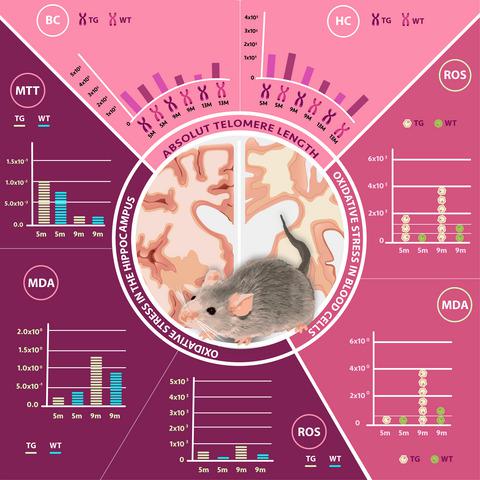当前位置:
X-MOL 学术
›
Eur. J. Neurosci.
›
论文详情
Our official English website, www.x-mol.net, welcomes your feedback! (Note: you will need to create a separate account there.)
Telomere length and oxidative stress variations in a murine model of Alzheimer’s disease progression
European Journal of Neuroscience ( IF 3.698 ) Pub Date : 2020-06-28 , DOI: 10.1111/ejn.14877 Katia Martínez‐González 1, 2 , Azul Islas‐Hernández 1, 2 , José Darío Martínez‐Ezquerro 3 , Federico Bermúdez‐Rattoni 4 , Paola Garcia‐delaTorre 1
European Journal of Neuroscience ( IF 3.698 ) Pub Date : 2020-06-28 , DOI: 10.1111/ejn.14877 Katia Martínez‐González 1, 2 , Azul Islas‐Hernández 1, 2 , José Darío Martínez‐Ezquerro 3 , Federico Bermúdez‐Rattoni 4 , Paola Garcia‐delaTorre 1
Affiliation

|
Alzheimer's disease (AD) is the most common cause of dementia, and ageing is its major risk factor. Changes in telomere length have been associated with ageing and some degenerative diseases. Our aim was to explore some of the molecular changes caused by the progression of AD in a transgenic murine model (3xTg‐AD; B6; 129‐Psen1 <tm1Mpm> Tg (APPSwe, tauP301L) 1Lfa). Telomere length was assessed by qPCR in both brain tissue and peripheral blood cells and compared between three age groups: 5, 9 and 13 months. In addition, a possible effect of oxidative stress on telomere length and AD progression was explored. Shorter telomeres were found in blood cells of older transgenic mice compared to younger and wild‐type mice but no changes in telomere length in the hippocampus. An increase in oxidative stress with age was found for all strains, but no correlation was found between oxidative stress and shorter telomere length for transgenic mice. Telomere length and oxidative stress are affected by AD progression in the 3xTg‐AD murine model. Changes in blood cells are more noticeable than changes in brain tissue, suggesting that systemic changes can be detected early in the disease in this murine model.
中文翻译:

阿尔茨海默氏病进展的小鼠模型中端粒长度和氧化应激变化
阿尔茨海默氏病(AD)是痴呆症的最常见原因,而衰老是其主要危险因素。端粒长度的变化与衰老和某些退行性疾病有关。我们的目的是探索在转基因鼠模型(3xTg-AD; B6; 129-Psen1 <tm1Mpm> Tg(APPSwe,tauP301L)1Lfa)中由AD进程引起的一些分子变化。通过qPCR在脑组织和外周血细胞中评估端粒长度,并在三个年龄段(5、9和13个月)之间进行比较。此外,探讨了氧化应激对端粒长度和AD进展的可能影响。与年轻和野生型小鼠相比,年长的转基因小鼠的血细胞中发现端粒较短,但海马端粒长度没有变化。发现所有菌株的氧化应激都随着年龄的增长而增加,但在转基因小鼠的氧化应激与端粒较短之间没有相关性。在3xTg-AD鼠模型中,AD进程会影响端粒的长度和氧化应激。血细胞的变化比脑组织的变化更引人注目,这表明在这种鼠模型中可以在疾病的早期发现全身性变化。
更新日期:2020-06-28
中文翻译:

阿尔茨海默氏病进展的小鼠模型中端粒长度和氧化应激变化
阿尔茨海默氏病(AD)是痴呆症的最常见原因,而衰老是其主要危险因素。端粒长度的变化与衰老和某些退行性疾病有关。我们的目的是探索在转基因鼠模型(3xTg-AD; B6; 129-Psen1 <tm1Mpm> Tg(APPSwe,tauP301L)1Lfa)中由AD进程引起的一些分子变化。通过qPCR在脑组织和外周血细胞中评估端粒长度,并在三个年龄段(5、9和13个月)之间进行比较。此外,探讨了氧化应激对端粒长度和AD进展的可能影响。与年轻和野生型小鼠相比,年长的转基因小鼠的血细胞中发现端粒较短,但海马端粒长度没有变化。发现所有菌株的氧化应激都随着年龄的增长而增加,但在转基因小鼠的氧化应激与端粒较短之间没有相关性。在3xTg-AD鼠模型中,AD进程会影响端粒的长度和氧化应激。血细胞的变化比脑组织的变化更引人注目,这表明在这种鼠模型中可以在疾病的早期发现全身性变化。



























 京公网安备 11010802027423号
京公网安备 11010802027423号